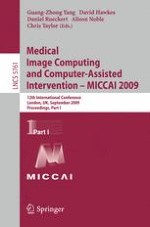The two-volume set LNCS 5761 and LNCS 5762 constitute the refereed proceedings of the 12th International Conference on Medical Image Computing and Computer-Assisted Intervention, MICCAI 2009, held in London, UK, in September 2009. Based on rigorous peer reviews, the program committee carefully selected 259 revised papers from 804 submissions for presentation in two volumes. The first volume includes 125 papers divided in topical sections on cardiovascular image guided intervention and robotics; surgical navigation and tissue interaction; intra-operative imaging and endoscopic navigation; motion modelling and image formation; image registration; modelling and segmentation; image segmentation and classification; segmentation and atlas based techniques; neuroimage analysis; surgical navigation and robotics; image registration; and neuroimage analysis: structure and function.
